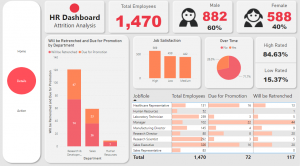In the vast realm of Human Resources (HR), a formidable challenge cast a shadow over a 1470-strong organization. This challenge was none other than the looming specter of employee attrition. HR professionals found themselves on a quest, embarking on a journey filled with data and insights to guide them through the labyrinth of talent management. Their goal? To unveil the secrets hidden within their diverse workforce and create retention strategies to ensure the organization’s enduring prosperity.

Chapter 1: The Mosaic of Employee Demographics
In the kingdom of this organization, 882 valiant male employees stood side by side with 588 resilient female colleagues. This vivid tapestry of gender diversity held great significance, for it encouraged HR professionals to tailor their initiatives to cater to the distinct needs and perspectives of both genders. Their mission: to foster an inclusive and supportive work environment that would unite this diverse army of employees.
Chapter 2: The Quest for Promotion
A peculiar duality emerged as they delved deeper into their data. While 72 seasoned employees were ready for promotion, having served the kingdom for over a decade, a much larger contingent of 1398 individuals remained ineligible, with less than a decade of experience. This paradox beckoned the need for finely-tuned career development approaches, as HR professionals sought to nurture talent effectively.
Chapter 3: The Battle of Employment Status
The majority, totaling 1353 employees, were designated as ‘On-service employees,’ faithfully serving the kingdom. Yet, a smaller group of 117 employees found themselves in the category of ‘On retrenched employees,’ on the brink of departure. This struggle highlighted the necessity of providing targeted support and solutions to those in jeopardy of leaving the kingdom.
Chapter 4: The Hierarchy of Job Levels
A closer examination revealed a diverse hierarchy of job levels. Job levels 1 and 2 enjoyed relative equilibrium, each employing 543 and 534 individuals, respectively. In contrast, job levels 3, 4, and 5 engaged 218, 106, and 69 employees, respectively. These insights highlighted the need for custom-tailored retention strategies that could cater to the varied needs and expectations across different job levels.

Chapter 5: The Commuting Conundrum
Employees were categorized as ‘Very close,’ ‘Close,’ or ‘Very Far’ from their workplace, with 940, 301, and 229 individuals in each category, respectively. This revealed valuable insights into the daily commuting experiences and potential challenges faced by the workforce. The knowledge gained was crucial for enhancing job satisfaction and improving retention, especially for those facing longer commutes.
Chapter 6: The Departmental Chronicles
As the HR professionals ventured further, they uncovered departmental disparities in retrenchment and promotion. The Research and Development and Sales Departments exhibited a balanced rivalry, with 74 employees retrenched and 47 due for promotion in each. In the Marketing Department, the ratio of 36 retrenched employees to 23 due for promotion intrigued them. The Human Resource Department faced a unique challenge, with 7 retrenched employees and only 2 eligible for promotion. These disparities beckoned for tailored HR interventions, specific to each department, to address attrition and advancement.
Chapter 7: The Quest for Job Satisfaction
Categorizing employees into ‘Highly satisfied,’ ‘Lowly satisfied,’ and ‘Moderately satisfied’ groups, HR professionals gained a snapshot of job satisfaction levels. With 569 employees highly satisfied, 459 lowly satisfied, and 442 moderately satisfied, they sought to decipher the factors driving satisfaction and dissatisfaction. This was the key to formulating effective retention strategies.
Chapter 8: Overtime Adventures
The division of employees into those who embraced overtime (28.3%) and those who didn’t (71.7%) unlocked profound insights into workload distribution, work-life balance, and job satisfaction. The data showed that managing overtime and its implications was vital in any retention strategy.
Chapter 9: The Revelation of Employee Ratings
The data revealed a substantial majority of ‘Highly Rated Employees’ at 84.63% and a minority of ‘Low Rated Employees’ at 15.37%. This classification served as a valuable compass for identifying high-potential individuals and those in need of additional support in their professional journey toward job satisfaction.

Chapter 10: The Path to Prosperity
In the end, armed with these invaluable insights, HR professionals set forth on their mission to create retention strategies that aligned with the unique needs and circumstances of their diverse workforce. Their strategies included enhancing job satisfaction, creating pathways for promotion, and fostering a harmonious work-life balance, all of which contributed to the reduction of attrition and the retention of top talent. Their data-driven decision-making illuminated the way to enduring prosperity for the entire organization.
And so, the tale of HR attrition and the quest for retention strategies came to a close, with HR professionals empowered by their newfound knowledge, ready to shape a brighter future for their organization.
